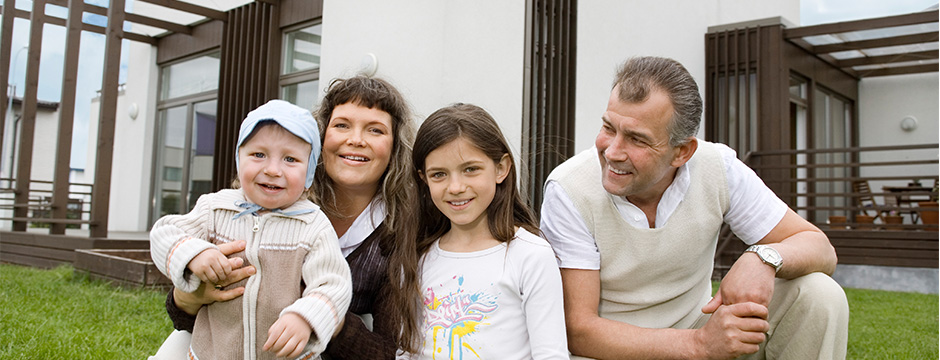| Builder and residents | Four person family |
| Year of construction | 2012–2015 |
| Floor area | 240 m2 |
| Volume | about 900 m3 |
| Heating system | hybrid heating system |
| Energy class | B |
| HVAC design | Aki Mikkelson |
| Solution | Enervent Pegasos HP Aqua ventilation unit with a rotating heat exchanger, integrated extract-airsource heat pump and dehumidification function |
| Required heating power | 9.5 kW |
| Ventilation cooling power | 3.5 kW |
| Ventilation cooling power with dehumidification |
8.7 kW |
| Design air flow (cooling) | 290 l/s |
Straightforward hybrid solution
A professional selects an uncomplicated and highly reliable ventilation and heating system for his home.
As a professional in the construction industry, the builder of this house is also familiar with the latest options and understands quite well what objectives should be included when building as energy efficient a detached house as possible in a cost-effective manner – and what objectives are not yet quite reasonable.
– For the time being, there is not enough know-how about passive houses, let alone on zero-energy houses, to make them reasonable options, especially for a self-builder. Even for a professional, they require in-depth expertise, experience and special attention, he points out.
Durable and cost-effective
Like many Finnish men, he wanted to build a home for his family himself. But because a busy working life and a growing family set certain limits on the time available, decisions on certain basic factors had to be made at the beginning of the project.
– It takes time when you are building a house yourself with your father. I have done the building mostly during the summers, and I do not yet dare to promise that we can move to our new home by Christmas 2014. Therefore, the materials and construction methods had to allow for a long building time.
A masonry house is a durable and safe solution. The insulated block structure produces walls that need only appropriate surfacing. Hollow-core slabs are used above the basement floor.
The energy class of the building will be B, a low-energy class. Passive construction was not possible with the selected type of EPS blocks. The structures are designed to be as airtight and as well-insulated as possible. The roof was insulated with polyurethane to ensure the best possible thermal insulation capacity and airtightness, and to maximize space.
The family will have a second child in fall 2014, and they have also considered getting another husky. The total area of the house is about 300 m2 over one story, which is a sensible solution for a family home. The basement will include a mechanical room with extra space for hobbies.
Focus on comfort
The lounge area has large windows because the amount of natural light was something the family did not want to compromise on. The energy-efficient windows have anti-fog coating and also a sun control coating to prevent the room from becoming overheated in summer.
– Still, cooling the indoor air in one way or another had to be taken into account in the ventilation system design, the builder remarks.
The builder considered the heating and ventilation solution for his house in cooperation with HVAC designer Aki Mikkelson. Various options were discussed in terms of investment and operating costs, and the final decision was made with the emphasis on comfort.
In a family with several children and pets, underfloor heating is a major comfort factor. The consumption of domestic hot water is also high. In addition to a Pegasos HP Aqua unit, water in the house is also heated by a heat-storing fireplace with water circulation. Heat is stored in a 750-liter Akvaterm accumulator tank.
Everything else is provided by a single unit, Enervent Pegasos HP Aqua, which also includes the dehumidification function. The unit is a ventilation unit equipped with both mechanical heat recovery system (rotating heat exchanger) and an integrated extractair-source heat pump. Therefore, its heat recovery capacity is notably higher than that of the traditional heat recovery solutions. Excess heat from the heat pump is stored in the accumulator tank from where it can be used for heating.
Efficient in every respect
On hot summer days, the main reason for a feeling of discomfort is not the temperature itself but the high humidity level. If the excessive moisture is removed from the indoor air, the air needs to be cooled only slightly to make it feel pleasant. Due to the dehumidifying operation, the extract-air-source heat pump of the Enervent Pegasos HP Aqua unit cools the supply air to about +7…+10 °C. Then the after-heating coil heats the air to +17…+19 °C, and the air is blown in at this temperature. Even during the most humid heatwave periods, all rooms have a constant and comfortable indoor air quality.
An energy-efficient ventilation system takes account of changes in conditions both indoors and out. The Enervent Pegasos HP Aqua unit is controlled by an integrated carbon dioxide sensor and a humidity sensor. The ventilation rate is boosted by a signal from the humidity sensor after taking a shower, for example.
Aki Mikkelson says that designing a ventilation system for an airtight, energy-efficient building requires thorough research of the various options and careful calculations. – The air flow rates must be designed to the correct level, and the cooling function makes this more challenging. We also studied a demand-controlled, room specific ventilation system as one option for this project but it was discarded due to higher costs. This made balancing the ventilation system challenging because the system balanced for the design condition had to be balanced also for lower air flow rates, he explains.
In a demand-controlled ventilation system, the air flow rates are controlled with room-specific flow rate controllers based on occupancy. This means that the system sets the ventilation rate in an empty bedroom to a lower setting with the flow rate controller, while the ventilation rate in other rooms remains unchanged. If this control system is not included in the design but cooling must be included, the air flow rates must be adjusted to the high flow rates of the cooling mode, but it must also be ensured that the ventilation rate is sufficient at low air flow rates in the rooms at the end of the ductwork.
If the dimensioning is correct, the indoor air quality is good and the ventilation system works correctly in all conditions.




